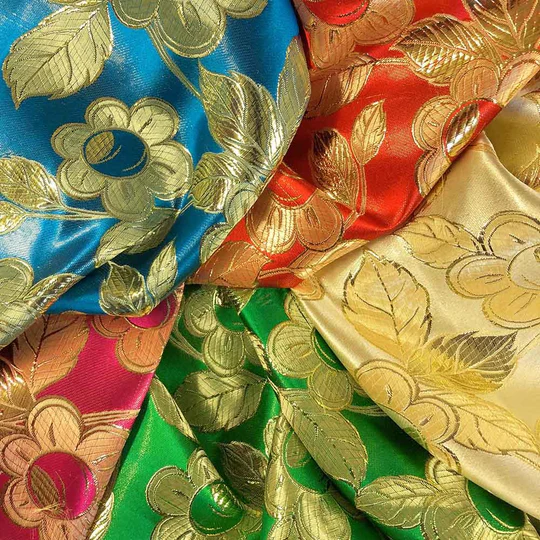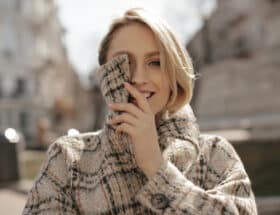Originally published by Pauline Weston Thomas
updated 12/05/2022
- Introduction to Damask and Brocade Fabric
- The Play of Light on Damask Fabrics
- Basic Weaves Warp/Weft 1/1, 2/2, Twill, Satin
- Jacquard
- Jacquard Brocade
- Brocade Fabric
- Brocade Fashion 2013
Introduction to Damask and Brocade Fabric
Damask fabric and brocade fabric both have a long history. From the 6th century, and for many centuries damask and brocade fabrics were only used as an indication of status and as garments kept especially for ceremonial events. The richly patterned black fabric is the most glamorous of clothing since it needs no further embellishment.
Historically, damask was originally a technique woven in China and this technique spread to the Middle East.

It is thought that the skill of making this beautiful style of fabric travelled to Damascus, a city in Syria.
Textile history suggests that the fabric was taken from Damascus into Europe by the Crusaders and this is how it gained the name Damask.
Brocade has always been associated with luxury and opulence. It has been used both for clothing and for furnishings.
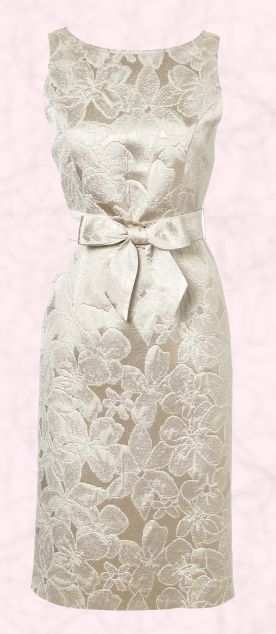
Down the eras, brocade has come in and out of fashion as Japanese style and house interiors dictated.
Damask and brocade are related patterned fabrics in that they both exploit the play of light falling on the weave structure. Long floats of warp and weft create patterns through subtle contrasts.
The Play of Light on Damask Fabrics
Damask is a woven fabric that is self-patterned. In simple terms, it is a satin weave and the patterns have a reversible positive/negative image. It relies on the play of light to give dimension to the pattern which is subtle and rich at the same time. One side of the damask cloth always has a darker face than the other.
The satin formation in a damask fabric creates areas of motifs rather than one large expanse of lustrous sheen as seen in a regular plain satin. The pattern is created when light falls on the damask fabric. The light reflects off areas of visible arranged fabric warp threads which look shiny against visible weft threads which look dull within the weave.
The Damask weave is created by allowing the warp yarn (flowing down), to float over a greater number of weft yarns (flowing across) than in a basic satin fabric weave. In addition, the warp yarns used to make damask fabric, are selected to be a very lustrous form of the yarn.
Damask fabrics use a silky lustrous warp of either silk, lustrous cotton, rayon, polished linen yarns or modern high lustre polyester yarns.
During weaving the floating warp has to be caught down and taken to the other side of the fabric making the weft become visible until the warp yarn is brought through again. This creates fabric pattern which is also reversible.
The intricate design usually uses a thicker matt yarn for the weft and so the weft lines running across show up as a pattern against the smooth satin areas of the shinier warp yarns.
Because many of the weft yarns are also longer in the intricate pattern arrangement, they show up in the reverse face pattern as long matt ridges. Some of the shorter wefts allow for more subtle effects to be created as they create a play of lower key shadow and light.
Damask weaves need to be made of a high number of threads per inch to be sturdy. The number of threads per inch is called the count of fabric. The higher the count the more compact the fabric and the less likely loose threads will pull out and snag. Double damask weaves produce the finest results, but the technique is more costly.
Basic Weaves
Warp and Weft
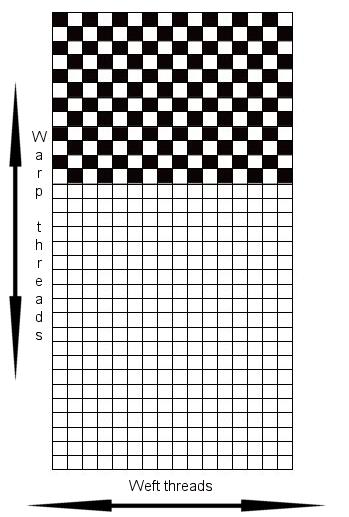
All weaves consist of warp threads which run down the length of fabric and weft threads (also known as woof threads) which pass over and under the warp threads.
To help understand damask fabric one must first understand the most simple one / one basic weave and then the basic satin weave. Here are some diagrams of basic weaves.
Basic 1/1 Weave
All woven fabrics are composed of warp threads which run down the length of a fabric.
Weft threads (often known as woof) are woven in and between the warp threads.
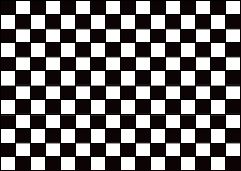
Using a thick needle threaded with weft yarn, many readers will have made this basic weave using a piece of craft card in school. Children learn to weave a yarn in an out of the warp threads wrapped around the card.
A single weft thread passes over a single warp thread.
Basic 2/2 Weave
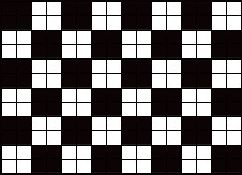
This is a basic 2/2 weave.
Two weft threads pass over 2 warp threads at a time and create a 2/2 weave, commonly known as hopsack or basket weave.
If you remember, the warp flows downwards, while the weft flows across.
Basic 2/2 Twill Weave
This is a basic 2/2 twill weave.
See how this example creates slightly ridged fabric.
Denim jean fabric is made from a variation of this twill weave.
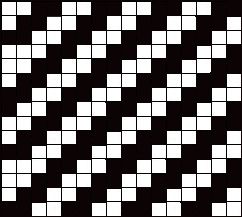
8 End Satin Weave
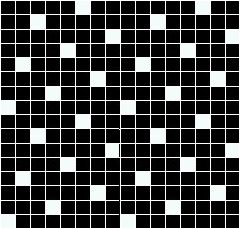
This diagram represents an 8 thread satin weave.
The long floats created mean the light that settles on the yarn is not so broken up and scattered as in a 1/1 weave.
Light is reflected off the long float of yarn and creates a smooth lustrous surface we call satin.
In Jacquard Damask fabrics the way the warp yarns and weft yarns interlace is a more complex arrangement of satin threads and this same technique is used to create a more ornate pattern.
Jacquard Damask
This lovely cream jacquard damask skirt is from Wallis and part of their autumn winter 2006/7 collection. You can see how rich and complex the jacquard pattern is, see how it flows and meanders into intertwined motifs.
In the making of early Jacquard fabrics punch cards were used to align warp yarns in pattern arrangements that moved with every line of punch card.
The first Jacquard loom was invented by Joseph Marie Jacquard (1752-1834).
He was a French weaver and was the the inventor of the Jacquard loom at the time of the industrial revolution.
The punched cards Jacquard invented, had a series of holes which controlled the pattern sequence perfectly.
The most tedious and time consuming part of the operation was creating new punched cards for every single new pattern.
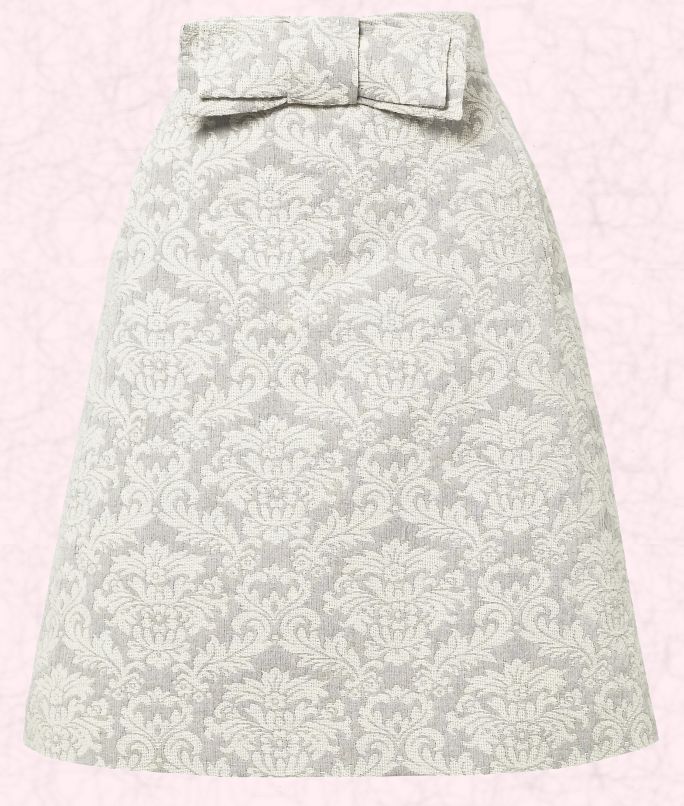
The Jacquard loom helped to revolutionise lace making and weaving. Even so it was still a very complex process to set up a jacquard loom and there was much hostility by skilled weavers to this mechanisation of the weaving industry.
You can see such old Jacquard lace looms in action at Nottingham Lace Museum at 3-5 High Pavement, The Lace Market, Nottingham NG1 1HF, England UK. You can also earn more about workers fear of mechanical inventions by checking out terms like Chartists, Luddites and Rebecca Riots.
Damask Vs Brocade
Damask and brocade are patterned fabrics woven. They are woven on Jacquard looms. Damask fabrics are flatter than brocade fabric. Meanwhile, brocade has a pattern like embossed. Brocades are not reversible whereas the fabric damask is.
Damask patterns are shiny as they are woven using the pattern in satin weaving. Brocade fabric uses metallic threads to create more shininess (Peacock Alley, n.d.). Damask and Brocade fabrics have differences in terms of origin too. The damask fabric has its origin in Damascus country. Meanwhile, India’s Banaras is famous for its Brocade fabric origin. Damask prints appear as royal to get used in curtains, and bed sheets.
On the other hand, brocade fabric uses a satin weave with a plain twill. Damask fabric is not much elegant and bouncy as brocade fabric. Brocade fabric is stiffer whereas damask is smooth. Damask fabric is wearable for all since it is woven in cotton. The fabric is durable which increases the drapery fall. If we talk about brocade fabric, brocade fabric is gentle.
But the brocade fabric requires careful handling. This fabric is also sensitive to both heat and humidity. Damask prints are printable. They mostly get used in bridal attires.
Damask can be a suffice to the needs. It also can be a great substitute for Brocade as the damask fabric can be used for alternative purposes.
Jacquard and CAD (Computer Aided Design)
In the latter C20th such machines became computer controlled using electronics in CAD (computer aided design) systems. Complicated patterns and picture effects are made possible by the computer programme instructing the loom to move the threads into new positions.
Automatic design formation is easily achieved with modern jacquard computer aided looms. Light, shade, and texture of any fabric design is all dependant on how much warp or weft is foremost.
Because of this CAD machinery we are able to afford fabrics that were once so costly, that historically only the very richest of people could afford them.
Jacquard Fabric
Jacquard fabric is a natural and synthetic fiber made of interwoven fabric on a Jacquard loom. Only the fabric woven with the Jacquard loom is considered genuine. Jacquard fabric has weaving complex fabric. Jacquard fabric has not popular as an apparel textile.
In making Jacquard fabric, first, the material must be acquired, it can be synthetic, cotton, or wool. After that, the manufacturers spin the textile fiber into the yarn. Next, choosing programs have been chosen by manufacturers. After that, the Jacquard looms into the weaving apparatus by feeding yarn. At the last, manufacturers expose the finished fabric to enhance its durability.
Jacquard fabric has multiple uses for homeware, clothing, and Bedding.
Jacquard gets utilized to make drapes and curtains. In the case of bedding, Jacquard gets used in pillows and duvet covers. The price of complex patterned Jacquard woven fabric is not expensive.
Jacquard Brocade Fabric
Damask and brocade are both made on a jacquard loom. Damask though is a flatter patterned fabric which is reversible. Brocade is richer in texture and often uses several colours.
Brocade designs look best on the top face of the fabric surface.
Because of this brocade fabric is often used for very opulent dressy garments such as ecclesiastical robes and evening wear.

Brocade is only rarely reversible with most designs looking best on the top face, but dressmakers sometimes use small areas of the brocade fabric reverse to achieve understated effects for toning bindings etc. It really does depend on the scale of the pattern too.
Today brocade can be made using any number of lustrous yarns including man made yarns such as viscose rayon which can be made to appear almost silk like.
Chinese brocade is almost always woven with silk yarns and with typical meandering Chinese patterns of branches, cherry flowers, dragons and Chinese symbols.
Smaller brocade patterns with metal threads are often woven on more basic looms, but as long narrow strips. Large scale intertwining flamboyant floral and fleur-de-lis effects in both damask and brocade have to be produced on the largest of looms the Jacquard loom.
Brocade Fabric
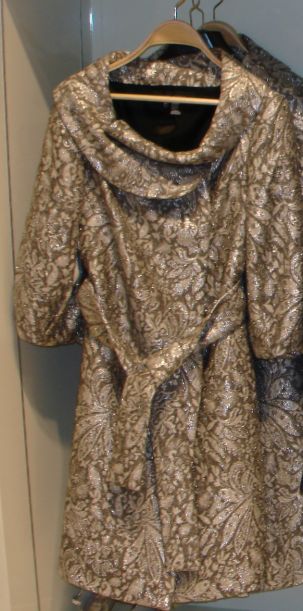
Designers have recently looked to the past in order to revive one the most loved of fabrics - brocade.
Manufacturers have produced a range of luxury brocade fabrics using up to date computer aided design technology and modern yarns.
These luscious materials are a blend of old with new.
Basically, modern yarns are used with an old technique.
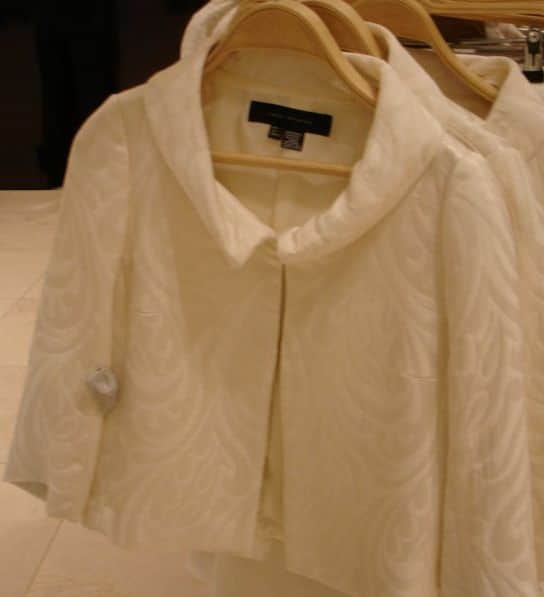
The weaving technique is the same one that is used on the sort of subtly patterned linen tablecloths (damask linen or even modern poly/cotton damask) that you see in good restaurants.
Brocade is slightly different from damask. The principle is much the same, but usually, one highlight color or several colors are used to draw greater attention to the pattern. Often the color will be a toning, but darker contrast is used to outline and create solid highlight areas or it will be woven with a gold metallic thread.
This contrast thread or mixed use of various colored threads produces a more textured fabric surface that is raised in some areas and which has depth. Because the metal threads are so often used some brocades can feel scratchy and because the fabric is costly it is mostly used to make up outerwear items that will be seen.
The picture on the right, is of a jacket in creamy simple brocade fabric, one that I photographed when last in Zara. The fabric in the Zara coat on the left is brocade, but shows use of coloured metallic thread which throws up the pattern more.
Brocade and damask fabrics were shown in many designer shows in 2005 and 2006. As you can see by autumn 2006 the use of brocade in fashion reached new heights in mass produced goods.
What is Brocade Fabric Used For?
Brocade, another name for “Embossed Cloth,” refers to the patterned woven fabric. Silk has been the primary fiber for brocade fabric used for casual garment outfits. There are complex weaves of brocade fabric with a single-colored pattern. Because of the Jacquard loom invention, brocade fabric production has become efficient.
Brocade fabric is often used for homeware, furniture, and accessories. In homeware, there are curtains and drapes where the brocade patterns get used. In the case of Furniture, brocade fabric gets used in making an ornamental chair with cushions, and sofas are brocade patterned. On the other hand, brocade is one of the choicest fabrics for throw pillows.
Because ornamental pillows impact to create a sophisticated atmosphere for any kind of setting. Other than these 3 areas, there are available areas like upholstery, costumes, and vestments. There are brocade fabrics are sturdy in nature. In upholstery, brocade serves the dual purpose to beautify the furniture. Brocade fabrics have usages in religion.
The use is the depiction of the Christian subjects in the fabric woven. Men also wear brocade-made ties, pocket squares, and bow ties. Brocade fabric is soft and utilized in evening outfits, dresses, trousers, and coats.
Modern Jacquard fabrics have a number of varieties including natural cotton, silks, polyester, and polyester blends. They only differ in the construction method. Jacquard fabrics are reversible in most cases.
Images all courtesy of Wallis/Arcadia and Marks & Spencer.
